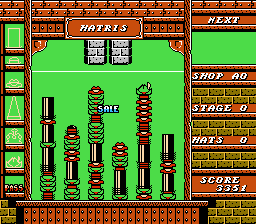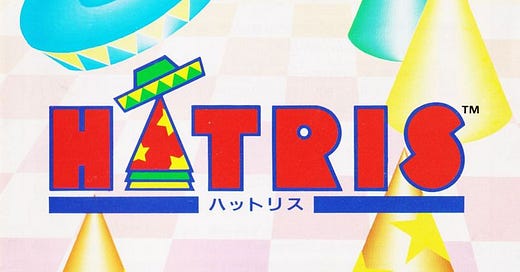It's new to me: Hatris
A sequel to Tetris, in the sense it was designed by the same developer and is also a falling "block" puzzle game.
This column is “It’s new to me,” in which I’ll play a game I’ve never played before — of which there are still many despite my habits — and then write up my thoughts on the title, hopefully while doing existing fans justice. Previous entries in this series can be found through this link.
The origin story of Tetris is pretty well-known at this point — there’s even a movie about it, starring Taron Egerton as Henk Rogers — but what about what happened after Tetris? Not in the sequels to Tetris sense, either. What did Alexey Pajitnov, the creator of Tetris, do as a follow-up to his world-changing hit? Another puzzle game, of course, but there weren’t any tetrominoes to be found here. Instead, there were hats. Lots and lots of hats.
Multiple versions of Hatris — get it? Hats and Tetris, Tetris with Hats, it’s Hatris — are set to be included in Digital Eclipse’s upcoming Tetris Forever, the latest in their Gold Master playable documentary series, but its association with Tetris has more to do with who was behind both of them than anything else. You aren’t making lines to clear here, but instead, you’re stacking hats on mannequin heads in order to “sell” product, which is how you score points. The hats do come in different shapes and sizes, and you need to stack five of the same on top of each other to clear them and score some points slash dollars, but everything is vertically based, unlike with Tetris’ multidirectional pieces, and the hat sizes aren’t beholden to the rule of tetrominoes — a tetromino isn’t just what you call a piece in Tetris, but an actual geometric shape made up of four squares connected at the edges. Sure, the long line feels bigger than the other pieces, but they’re all four-square shapes in different configurations, taking up the same amount of space. The hats are hats: some of them are bigger, some of them are smaller, and you’re going to have to work around that when making decisions about where to drop them.
Hatris can play a bit differently depending on which version you’re experiencing. In every release, two hats fall at the same time, connected, until you drop one on one stack, and you can rotate the hats like you do puzzle pieces in pretty much every other falling block puzzler, as well. Then the other is freed for you to move it to a different mannequin head or existing stack (obviously, that other stack has to be shorter than the one you placed the first hat on, since the second hat is still dropping during this time). In each, five of the same hat stacked on top of each other causes a clear of those hats. Beyond those core design decisions that make it Hatris, though, there was room for improvisation.
For example, in the Famicom edition of Hatris — which released before the NES one — there is a “Sale” screen in between levels, where you can choose a specific kind of hat to “sell” it, clearing it from your screen before the next stage begins. Your hats carry over from level to level, and new hats are introduced, further complicating matters as you progress — this is how things work instead of an increase of speed being your impediment to continuing onward, a la Tetris. In the NES edition, this Sale screen doesn’t exist: instead, you have two different helpers, for whom you earn opportunities to utilize as you clear more and more hats. One helper is Alexey, as in Pajitnov, while the other is Vladimir, as in Vladimir Pokhilko, the co-designer of Hatris alongside Pajitnov. You can hold up to eight of these helper uses at a time, and you earn them by clearing specific hat types: top hats, wizard hats, and crowns are for Alexey, while derbies, baseball caps, or cowboy hats get you a Vladimir. You don’t get to choose which helper will arrive, as it’s just whichever is next on the pile, but pressing B wipes the current falling hats from the screen and summons that helper.
Alexey can remove five hats from any of the columns, from the bottom, which can be especially useful if you’ve got some taller hats, like the top hats, stuck under a pile of shorter hats and need to clear some vertical space between those columns and the top of the playing area. As with Tetris and basically everything else in the genre, your pieces reaching the top of the playing area means game over. As for Vladimir, he can swap columns with each other, which can be good if you’ve got some weird height issues going on that makes moving your second hat to a new stack difficult.
Since you’re constantly earning these helpers with enough clears of specific hat types, you have the option of selling these in the NES edition, instead of hats, in between levels. Maybe you’re already full up at eight of these of clearing a stage, so you’re basically cashing these in for points by betting that you won’t use what’s remaining of your stock before earning some more to make up for what you parted with. Like with how you don’t sell hats in the NES version of Hatris, this helper system doesn’t exist in the Famicom one. And while both the arcade original and Famicom edition do have the Sale system, it works differently within, as point bonuses exist for clears caused by sales in the former.
And then the Game Boy edition doesn’t have either of these systems in it. Instead, you get fireballs. Sure, why not? That’s how hat stores normally clear out their extra stock, right? With the cleansing power of fire. Using a stored fireball will convert one of the two hats in your falling piece into fire, which can then be used to burn a column it touches. Unlike with the eight helper icons, you can only store two fireballs at a time. Earn a third fireball, and the second hat in your piece turns into a helmet, which crushes the column it lands on beneath it. This is also your only way toward a combo in this very specific “block” clearing game: crowns can’t be crushed, and helmets crush, so you can set things up so that you can clear both a stack of helmets and a stack of crowns that were on top of each other at the same time. This — meaning, clearing the entire column with a combo — is a “Hatris,” and there’s a more complicated “Super Hatris” variant, as well, that involves a third hat type clearing at the same time. I don’t think I have the skill for that one, but maybe with enough playing time, luck can play a factor.
ParaGraph — Pajitnov and Pokhilko — developed the arcade, Famicom, and NES editions of the game, with Bullet-Proof Software publishing the latter two and Video System (the Aero Fighters/Sonic Wings company) handling the arcade edition. Bullet-Proof Software handled the Game Boy release, development and publishing, on their own. And then you have additional versions like the PC Engine’s, which was sublicensed to Micro Cabin — they handled both the development and publishing of that edition of the game. The PC Engine version also omits the Sale screen and the helpers, and instead opts for the fireball of the Game Boy edition, though, it works differently here, as the fireballs are random drops instead of something to be earned and stored. It’s visually distinct from the NES/Famicom versions of Hatris, as well, with the hats being stacked on top of actual people. How do you know they aren’t just mannequins, even though the visual design more closely matches the arcade game? Because if you drop a fireball onto a head with no hats on it, they have an animated reaction in both senses of that word. They also don’t have the same hair that they used to before you singed it off, and burning them a second time will take care of what’s left of their hairdo.


It’s a strange decision in terms of the original “you’re putting hats on display in a window and selling them” design, but Micro Cabin wasn’t married to any part of that, even dropping the idea of earning cash for clears in favor of straight score, so why not do something a little weird that makes me cackle, instead?
While the Famicom, NES, and Game Boy editions of Hatris are included in Tetris Forever, the PC Engine edition is not. Tetris Forever seems to heavily focus on games Bullet-Proof Software was involved in in some capacity or another — not exclusively, no, but everything in the collection after the original Elektronika 60 edition of Tetris and its Apple II release that predates Nintendo’s releases of Tetris on the Game Boy and NES are affiliated with Bullet-Proof Software. The arcade edition of Hatris is missing — Video System published that, remember — and Micro Cabin handled both development and publishing of PC Engine Hatris on a sublicensing deal. The canceled edition of Tetris on the Sega Genesis, developed by Sanritsu Denki and published by Sega, isn’t in the collection. Neither of Nintendo’s Game Boy or NES editions are included, and Tengen’s unofficial release for the NES also isn’t there. This isn’t meant to go hey what’s the big idea, Digital Eclipse, but is merely trying to suss out why certain versions aren’t included in the collection: Bullet-Proof Software played a massive role in Tetris’ international origins and continued sequelization, aligning themselves with Nintendo and Chunsoft and more for years,
Anyway! Hatris was ported to a number of platforms within a few year of its initial release, but then things slowed down on that front, and it hasn’t seen much life again until right now. You’ll be able to check it out for yourself, legally, in short order, but do yourself a favor and figure out how to play some of the other versions of the game that are out there, too. It’s a shame that this concept was never explored further a la the constantly experimenting Tetris, but at least Hatris went out of its way to present itself in a number of varied forms during its comparatively shorter window.
This newsletter is free for anyone to read, but if you’d like to support my ability to continue writing, you can become a Patreon supporter, or donate to my Ko-fi to fund future game coverage at Retro XP.





Never heard of Hatris! What a cool concept. Maybe it's time an indie game replicates it...
I picked up an NES cartridge of this about 15 years ago and I adored it! I’m really pleased to see you come across it and write it up (and I learned about the versions I have not played)!